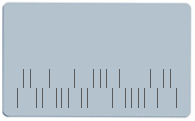
Recently, our CEO, David Carta, called me into his office and asked me, “Mark, what is Wiegand?” He was instructing a new Telaeris employee about XPressFreedom, our Wiegand to Ethernet converter which we use to enable mobile access control with existing system. He thought that I, as our sales lead, should be able to give an appropriate explanation. Like a deer in the headlights I froze, knowing that I did not have a solid, technically sound answer. Feeling the gaze of our newest employee upon me, I threw a panicked cookie-cutter answer against the wall, hoping that it would be satisfactory. It wasn’t and I knew it. Worse, I knew Dave knew it. Fortunately, he didn’t lambaste me in front of our new co-worker, but as I left the room, my tail was hanging between my legs.
Later that day, Dave called me into his office to address the encounter from earlier in the day. Part of Telaeris’ culture is to deliver the very best support and knowledge to our clients, in our efforts to be the worldwide leader in handheld badge verification solutions. As our primary salesperson, he wanted to be sure that I could provide top notch technical knowledge, in order for me to provide the very best service possible to our customers. Dave’s instruction to me came in the form of a challenge, “Mark, I want you to write our next blog article about Wiegand.”
Simple enough right? With Google and the entirety of the World Wide Web at my fingertips, I did some light research and quickly threw together a rough draft and presented it to Dave. “Mark, this isn’t technically accurate. Go back and dig deeper.” I buckled down and continued to research the history of Wiegand and how it works. I discovered that while the technology started with magnetized wires, today Wiegand refers to an entire interface upon which the access control industry is based. Even more, I learned that I wasn’t alone in my confusion. Many others shared my question, “What is Wiegand?”
Wiegand’s Origin
John R. Wiegand moved from Germany to the United States in the 1930’s, in order to study piano and choral conducting at New York’s world famous Julliard School of Music. He later became an engineer, but it was his perfect pitch that allowed him to hear changes that occurred as his wires were magnetized that led to his discovery of the Wiegand Effect in the early 1970’s.

Wiegand wire, patented by Wiegand in 1974, is composed of a magnetic iron-alloy that is designed to form a hard outer casing around a softer inner core. When passed through a magnetized field, the outer shell magnetizes quickly until it reaches full capacity. Once this occurs, the inner core begins to magnetize, and then surprisingly, the core and shell switch polarity. This creates a significant voltage pulse until the wire reaches full magnetization. These voltage changes are easily detectable and result in the pulses that are sent down the D0 and D1 lines.
In the late 1970’s, Wiegand and his business partner, Milton Velinsky, developed a card using Wiegand wires for access control purposes. They positioned two separate rows of wires in the card, which when passed over a magnetic field, created varying voltage outputs which are treated as a signal. The Wiegand interface is for readers that could detect these cards output data over two signal lines called D0 (Data Zero) and D1 (Data One). This sequence of 1’s and 0’s is mapped to a binary number. Wiegand’s card was seen as an improvement over existing mag-stripe cards which could be re-written easily. Not only could Wiegand cards not be re-written, they were difficult to manufacture, which meant they were difficult to counterfeit.
Wiegand Today
This D1/DO interface along with Clock/Data (used for mag-stripe) have persisted since the 1970s as the de-facto interfaces for access control card readers. When most people today talk about a Wiegand card, they are not thinking about a card with wires. Most often they are talking about an RFID enabled card (i.e. Prox, Mifare, iClass, etc.) that outputs card data using Wiegand’s D0/D1 interface.

A Wiegand format is simply a defined series of binary data transmitted over the two output wires. The industry standard for the first decade was a 26-bit format, using 8 bits for the facility code, 16 bits for the user ID. Today, there are many different and custom formats, with the largest being a 200 bit PIV standard used by the US government. The card image below illustrates the use of 26-bit Wiegand.

While the Wiegand card is still in production, in the modern access control industry this technology has been largely replaced by newer, cheaper and more secure forms of access cards (i.e. Mifare, iClass, Proximity). The Wiegand interface, however, remains the standard convention for the transmission of data for any device (card, biometric, or PIN reader) to an access control panel.
In conclusion, what began as a simple challenge to learn more about Wiegand, quickly became a fascinating learning experience about the roots of the access control industry. Utilized across a broad scope of access control manufacturers, the Wiegand interface is still the beast of the industry, and it refuses to die off. The use of the Wiegand interface technology isn’t going anywhere in the near future, as the depth of its use far exceeds any up-and-coming technologies. Nearly fifty years ago, John R Wiegand discovered a cool way to manipulate the magnetic polarity of his custom wires; little did he realize that it would redefine an entire industry.
Two great sources of information, both written by Michael Davis on Wiegand are below:
We also have a more in depth explanation of Wiegand written up in our follow up blog post: D0wn and D1rty with Wiegand

This is awesome post ……
Good article on the history of Wiegand. I appreciate you taking the time to share.
Good article and explanation couldn’t be clearer.
I Googled a lot but no explanation is clear as yours.
I really appreciate.
Many thanks.
Giorgio.
Very interesting, thanks for sharing.
Awesome article. It helped me a lot!
Thank you.
Bruce Gennette submitted the following detailed comment about Wiegand:
In the ‘Wiegand Wire’ paragraph – The part about when the wire passes through a magnetic field is Ok but could be explained more like ‘how a changing magnetic field affects the wire’.
Here’s how I explain it to my students –
Wiegand’s Vicalloy is a commercial alloy of Iron, Cobolt and Vanadium, which, when work hardened as a 0.25mm diameter wire through a multi stage proprietory process of twisting and untwisting while under different stretching tension levels followed by an artificial aging by self heating from passing a current along it to develop an easy_to_magnetise core with a hard-to-magnetise skin. These tiny wires are called ‘Wiegands’. Other processes exist to create the opposite structure, which also works, even in multi-layered, flat sheets.
When a fully magnetised Wiegand is subjected to an opposite polarity, external, increasing magnetic field the skin resists changing polarity and effectively shields the core up to a field strength of ~1mT, where the core will suddenly flip its polarity and induce a large surge of the new polarity adding into the external magnetic field (the Barkhausen effect) that creates an easy to detect electrical pulse >2V in an adjacent coil of wire. The magnetically hard, thin skin will also flip polarity when the combined external magnetic field and the core magnetic field become strong enough (~6mT), but this is a ‘softer’ flip that doesn’t produce a very large pulse. There is no point in increasing the magnetic field strength at the wire beyond ~10mT as no further change is possible until the external field polarity is reversed.
The pulses are produced from any source of external, increasing magnetism such as a spinning magnet of the application of a sine wave to an electromagnet. The same electromagnets may be used for generating the external fields AND for detecting the sudden pulses so this is the most common method used.